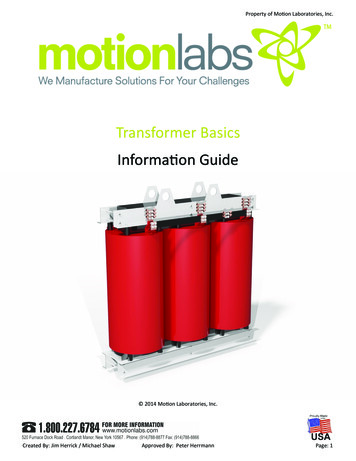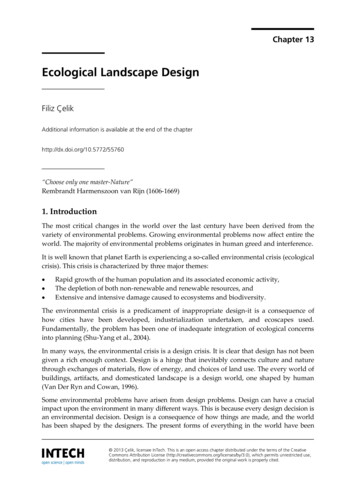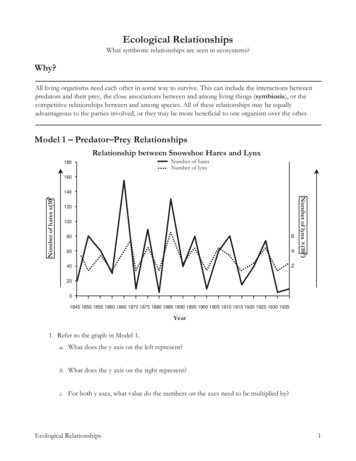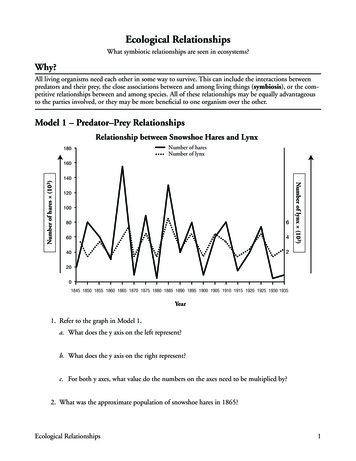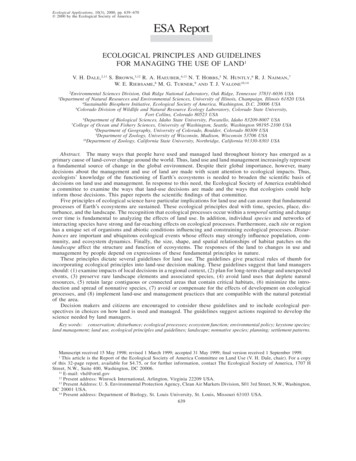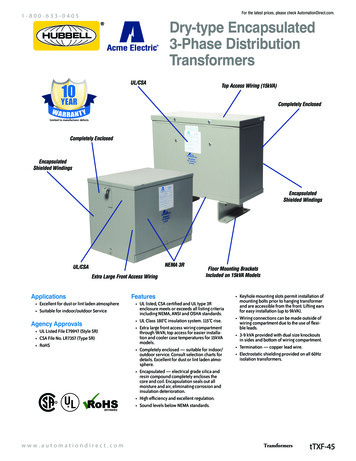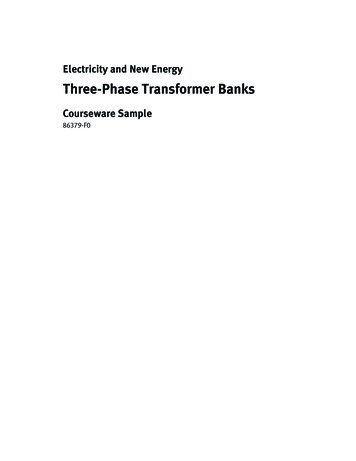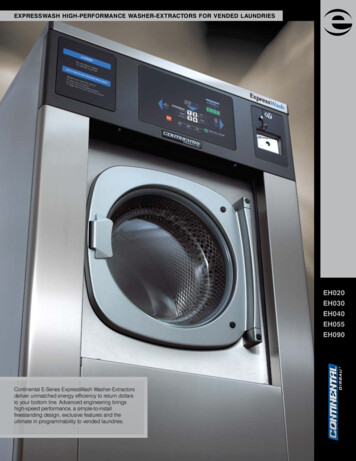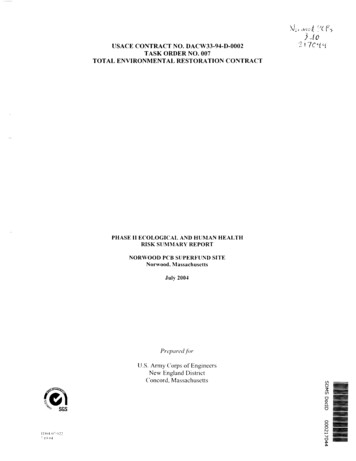
Transcription
l.'ioUSAGE CONTRACT NO. DACW33-94-D-0002TASK ORDER NO. 007TOTAL ENVIRONMENTAL RESTORATION CONTRACTPHASE II ECOLOGICAL AND HUMAN HEALTHRISK SUMMARY REPORTNORWOOD PCB SUPERFUND SITENorwood, MassachusettsJuly 2004Prepared forU S Army Corps of EngineersNew England DistrictConcord, Massachusettso* 'SGS\7C-
USAGE CONTRACT NO. DACW33-94-D-0002TASK ORDER NO. 007TOTAL ENVIRONMENTAL RESTORATION CONTRACTPHASE II ECOLOGICAL AND HUMAN HEALTHRISK SUMMARY REPORTNORWOOD PCB SUPERFUND SITENorwood, MassachusettsJuly 2004Prepared forU.S. Army Corps of EngineersNew England DistrictC'oncord, MassachusettsPrepared b\Tetra Tech FW, Inc.133 Federal StreetBoston, Massachusetts 02110Revision0Date7/19/04Prepared ByJ Schaffer/R. MarnicioApproved ByJ. ScaramuzzoPages AffectedAll
TABLE OF CONTENTS10INTRODUCTION20FCOI OGICAL RISK ASSESSMENT FOR THE NORWOOD PCB SITE21Habitat Observation and Descriptions2 1 1 Habitat Descriptions22Wildlife23Refined Conceptual Food Chain Model24Assessment Endpomt Identification2 4 1 Definition of Risk Questions2 4 2 Measurement Endpomts243Weight of Evidence Approach25Data Review and Quality/Usability Assessment26Analysis and Exposure Assessment2 6 1 Surface Water Screening Analysis2 6 2 Sediment Screening Analysis2 6 3 Uncertainty27Rapid Bioassessment of the Meadow Brook Benthic MacromvertebrateCommunity2 7 1 lotal I axa Richness2 7 2 Density2 7 3 Community Structure2 7 4 Functional Feeding Guild Analysis275Uncertainty2 7 6 Crayfish Bioaccumulation Studies2 7 7 Uncertainty28Risk Characterization and Determination for Benthic MacromvertebrateCommunities2 8 1 Community Structure and Function2 8 2 Bioaccumulation of PCBs by Invertebrates29Fish Community Structure and Bioaccumulation Assessment2 9 1 Fish Community Structure2 9 2 Uncertainty293BioaccumulationofPCBs in I ish2 9 4 Uncertainty2 9 5 Risk Characterization tor Fish Communities2 9 6 Risk Determination for Fish Communities in Meadow Brook210Semi-Aquatic Wildlife Exposure Assessment2 1 0 1 Toxicity Reference Value (TRY) Derivation2 1 0 2 Ha/ard Quotient Calculation2 11Summary2 1 1 1 Meadow Brook Aquatic Habitats2 1 1 2 Neponset River Aquatic Habitats30m -t i11 04HUMAN HFAI Til ASSI SSMFN I FOR 1 HF NORWOOD PCB SITI3 1Groundvvater32Soil and Sediment3 2 1 Surficial Soil in a Residential Setting1-12-12-12-32-42-4262-62-62-72-82-82-8292 112-112-132-132 162-162-172-172 192-192-192-192-202-202 232-232-2 2-252-262262-272282-352-362 18}1313131
TABLE OF CONTENTS - Cont 'd3.2.23.2.3Surficial Soil in an Industrial SettingSediments3-23-24.0CONCLUSIONS4.1Ecological Risk4.2Human Health Risk4-14-14-15.0REFERENCES5-1LIST OF FIGURESFigure 2-1Figure 2-2Figure 3-1Figure 3-2Figure 3-3Figure 3-4Phase II Fishery Survey, Benthic Community Survey, and Tissue Collection AreasFood Cham Model for Meadow Brook Adjacent to the Norwood PCB SiteAroclor 1254 - ResidentialAroclor 1254 - IndustrialAroclor 1254 - Sediments/ResidentialAroclor 1248 - Sediments/Residential2-22-53-33-43-53-6LIST OF TABLESTable 2-1Table 2-2Table 2-3Table 2-4Table 2-5Table 2-6Table 2-7Table 2-8Table 2-9Table 2-10Table 2-1111)04 07 022" I') 04Ecological Benchmark Comparison of Surface Sediments from Meadow Brook2-10Comparison of Surface Sediments from the Neponset River to Sediment ScreeningBenchmarks2-12Benthic Community Reconnaissance of Meadow Brook- Total Taxa2-14Benthic Community Reconnaissance of Meadow Brook2-15Crayfish Body Burden Data Meadow Brook Compared to NOAEL Values2-18Fish Species and Field Observations Recorded From Meadow Brook2-21Summary Catch Data for Redfin Pickerel From Meadow Brook2-22Comparison of Redfin Pickerel Body Burden Data to NOAEL and LOAEL Values. 2-24Belted Kingfisher Exposure Assessment to PCBs in Meadow Brook2-29Raccoon Exposure Assessment to PCBs in Meadow Brook2-32Mallard Exposure Assessment to PCBs in Meadow Brook2-34
ACRONYMS AND gNOAELPCBPECppmPROTECTERCTRYTtFWUSACEUSEPAwvvtI [X)4-07.0227 19 0-4micrograms per kilogrammicrograms per literAmbient Water Quality CriterioncentimeterEphemeroptera, Plecoptera, and TrichopteragramLowest Observable Adverse Effects EndpointMassachusetts Department of Environmental ProtectionMassachusetts Contingency Planmilligrams per kilogramNo Observed Adverse Effect Levelpolychlorinated biphenylprobable effects concentrationsparts per millionPreliminary Remediation Goalthreshold effects concentrationTotal Environmental Restoration ContractToxicity Reference ValueTerra Tech FW, Inc.U.S. Army Corps of EngineersU.S. Environmental Protection Agencywet weight111
1.0INTRODUCTIONThis report was completed under Task Order No. 07 of the U.S. Army Corps of Engineers (USACE)Contract No. DACW33-94-D-0002, Total Environmental Restoration Contract (TERC) for hazardouswaste sites. Tetra Tech FW, Inc. (TtFW) has implemented Phase II of the field investigation of MeadowBrook at the Norwood PCB Superfund Site (the Site) in Norwood, Massachusetts. This work has beenexecuted in accordance with USACE Modification for Proposal No. 43. Phase I of the field investigationof Meadow Brook was previously completed and the results summarized in a technical memorandumsubmitted to the USACE in April 2004. The purpose of the Phase II investigation has been to assesspotential polychlorinated biphenyl (PCB) contributions from the Norwood Site to Meadow Brook and toexamine sediment PCB distributions downstream of the Norwood Site. Investigation results werepresented in the Phase II Field Investigation Report (TtFW, 2004).The specific objectives of the Phase II Risk Assessment include the following: Evaluate the groundwater soil and sediment data from the Phase II Investigation; Refine the Ecological Risk Assessment based on data acquired from Phase II investigations; Establish if existing risks to ecological receptors warrant the development of a site-specific waterquality criterion for Meadow Brook; and Assess whether results from the Phase II Investigation of Meadow Brook may raise any potentialhuman health concerns.Section 2.0 of this report summarizes the Ecological Risk Assessment. Section 3.0 summarizes theHuman Health Risk Assessment. Finally, conclusions from both the Ecological and Human Health RiskAssessments are provided in Section 4.0 and relevant references are provided in Section 5.0.I I ) H 4 01-H22" \1 1)4
2.0ECOLOGICAL RISK ASSESSMENT FOR THE NORWOOD PCB SITEThe ecological risk assessment for the habitats associated with Meadow Brook was refined based uponthe collected Phase I and II data. The following provides the reassessment using the Site-specificanalytical and biological survey data collected as part of the Phase I and II efforts.The objective of the task was to establish if existing risks to ecological receptors warrant the developmentof a Site-specific water quality criterion for Meadow Brook. The Site-specific ecologically based surfacewater concentration for PCBs would be applied at the Norwood Site and replace the current FederalAmbient Water Quality Criterion (AWQC) for PCBs. This Site-specific concentration is to be protectiveof the ecological receptors actually in or reasonably associated with the existing habitats within theMeadow Brook corridor adjacent to the Site. This task will provide the basis for a possible future waiverof the Federal AWQC for the Norwood Site if deemed necessary.In order to develop this criterion and supporting documentation, the following subtasks were performed.1. A re-survey of the habitat and species present in the Meadow Brook corridor and document theobservations with photographs and a field log.2. Review and refine the existing conceptual Site ecological exposure model and associated foodchain relationships (if necessary) based on the re-survey.3. Identify Site-specific ecological assessment and measurement endpoints and critical localecological receptors or resources that must be protected by application of the Site-specific surfacewater concentration for PCBs to be developed (if necessary).4.Perform a Site-specific ecological risk assessment to determine if ambient levels of PCBs presenta significant risk to representative ecological assessment endpoints determined to be appropriatefor Meadow Brook.5. Identify a surface water quality PCB concentration for Site-specific application that will protectthe identified ecological receptors, consistent with the general approach and assumptions used todevelop the Federal AWQC (as appropriate).The Site-specific ecological risk assessment was performed using guidance provided in USKPA (1997)and MADEP( 1996).2.1Habitat Observation and DescriptionsOn September 30, 2003 and October 31, 2003 a site investigation was conducted at the Norwood PCBSite in Norwood, Massachusetts. The purpose of the investigation was to collect community level datarelated to ecological resources associated with Meadow Brook adjacent to the Norwood PCB Site. Fieldsurveys included the following: Qualitative surveys of the vegetative communities present;Qualitative observations of wildlife utilization of the habitats present; andSemi-quantitative surveys of fish and benthic communities present.Figure 2-1 depicts the relative locations of where the benthic and fishery surveys were performed relativeto the Site.11)04-07-0:27 1904
2.1.1Habitat DescriptionsVegetative communities (aquatic and terrestrial) within the areas under investigation were characterized.Meadow Brook and associated wetlands associated with the Norwood PCB site were separated into fourvegetative communities consistent with sample stations BS01, BS02, BS03 and reference area BS04 ofthe benthic community survey. Surrounding adjacent upland areas were also characterized.2.1.1.1Riparian Vegetative Community at BS04The vegetative community along this section of Meadow Brook is characterized as a forested riparianarea with scrub-shrub, and limited emergent understory. Dominant plant species include red maple (Acerruhrum), American elm, European buckthorn, silky dogwood (Cornus ammonium), and poison ivy(Toxicodendron radicans) with lesser amounts of Norway maple (Acer platanoides), scarlet oak (Quercuscoccinea), gray birch (Betula popnlifolia). viburnum (Viburnum dentatum), burning bush (Euonymusatropurpureus), multiflora rose, various golden rods, stinging nettle (Ulrica dioica) and mugwort.2.1.1.2Riparian Vegetative Community at BS03The wetland community observed in this section of stream bank supports less species composition anddensity of emergent/submergent vegetation than BS-02, however the riparian shrub-shrub communitiesare similar. Reed canary grass, jewelweed, various smartweeds, purple loosestrife, beggar-ticks (Bidenssp.) and moss primarily dominate the wetland in and along the stream bank.2.1.1.3Riparian Vegetative Community BS02The wetland vegetative community in and along the stream bank of BS02 is similar in speciescomposition to BS01, however this section of stream bank supports a significantly higher density ofemergent/submergent vegetation and riparian scrub-shrub. Dominant wetland vegetation in and along thestream bank includes reed canary grass, manna grass, jewelweed, various smartweeds, purple loosestrife,broad-leaf cattail, pondvveed (Potamogeton sp.) and moss. Additional emergent/submergent wetlandvegetation identified in lesser amounts includes soft rush, lurid sedge (Carex lurida) and filamentousgreen algae. American elm. silver maple, and box elder with lesser amounts of European buckthorn(Rhamnus frangula), river birch (Betula nigra), catalpa, and common elderberry (Sambucus canadensis)characterize the riparian scrub-shrub community. Understory species observed within the adjacentriparian area include mugwort, multiflora rose, bittersweet nightshade and wild cucumber.2.1.1.4Riparian Vegetative Community at BS01The wetland in and along the stream bank is primarily dominated by reed canary grass (Phalarisarundinacea), jewelweed (Impatient capensis), various smartweeds (Polygonum sp.), and purpleloosestrife (Lythrum salicaria). Additional emergent/submergent wetland vegetation identified in lesseramounts include broad-leaf cattail (Typha latifolia), soft rush (Juncus effusus), manna grass (Glyceriasp.), filamentous green algae and moss (Fontalis sp.). American elm (Ulmus americana), silver maple(Acer saccharinum), box-elder (Acer negundo), catalpa (Catalpa bignonioides) and willow (Salix sp.)characterize the riparian scrub-shrub community. Understory species observed within the adjacentriparian area include mugwort (Artemisia vulgaris), multiflora rose (Rosa multiflora), bittersweetnightshade (Solatium dulcamara) and wild cucumber (Echinocystis lobata), with lesser amounts of crownvetch (Coronilla varia), orchard grass (Dactylis glomeratd) and various golden rods (Solidago sp.).TD04-07-022719049 -
2115Upland HabitatsThe surrounding upland mowed lawn and forested area associated with station BS04 was primarilydominated by green ash (Fra\inus penn l\a nca), scarlet oak, crab grass (Digitana \angmnali*,), fescue,English plantain (Plantago lanceolata), dandelion (Tara\acnm officmale), mugwort, dwarf cmquefoil(Potentilla tanadensis), poison ivy, morning glory (Ipomoea coccinea), red clover and butter and eggsThe surrounding uplands associated with BS01, BS02 and BS03 fallow field were primarily dominated bymugwort, orchard grass, fescue (Fescue sp ), white aster (Aster sp ), red clover (Trifohumpratense), reedcanary grass. Queen Anne's lace (Daucus carota) and multiflora rose Additional species observedinclude butter and eggs (Lmana vulgaris) and pokeweed (Phytolacca amencana) The man-madecreated ditch on-site consists of reed canary grass, various golden rods, multiflora rose, varioussmartweeds and blue vervain (Verbena hastata)2.2WildlifeWildlife species observed were consistent with species observed during the initial site reconnaissanceperformed in 1999 (FWENC 1999)2.3Refined Conceptual Food Chain ModelThe field survey of Meadow Brook was used to further refine the generic conceptual food chain modeldevelopment for the Norwood PCB Site This refined model would allow for validation of assumptionspresented in previous risk characterizations for Meadow Brook adjacent to the Site The on-Site surveyidentified several typical cosmopolitan wildlife species that inhabit marginal areas associated with humandisturbance and development These species included mallard ducks, evidence of raccoon and muskratoccurrence and the presence of strictly piscivorous species like the belted kingfisherThe ecological risk assessment process acknowledges that it is neither technically feasible nor practical toassess risk to every potential environmental receptor in an exposure pathway MCP and USEPA guidancestates that representative receptor species be selected to represent a trophic level or feeding guild forassessing local food chain effects This selection process was used to develop and refine a conceptualfood chain model that incorporates a variety of ecological receptors deemed representative of the ecologyof Meadow Brook This conceptual food chain model considered the following Ecological receptors common to or observed in the brook habitats, A simple food web applicable to the habitats observed on the island, Key endpomt receptors in the food web that may have the potential to bioaccumulate/bioconcentrate contaminants through contact with abiotic media or consumption of contaminatedbiota, Selection of species whose life history and ecology are documented in the scientific literature,and A basis for empirically determining potential risks to key trophic level receptors based upon thescientific literature, and fate and transport characteristics for the contaminants of concernFigure 2-2 presents the refined conceptual food chain model and representative species identified for thehabitats associated with Meadow BrookTD04 07 02271904?-4
T38ooTmoa. aifnoT3CN -S i;4)II00oTJ(001OQOc'(C OS aO CDZ DC
Risks to candidate ecological receptors were assessed to determine if the identified PCBs present inMeadow Brook pose a risk to these receptors. Candidate species were selected using the followingcriteria: Observation of their presence or expected occurrence on the island;Trophic level and feeding guild in relation to the habitats present; andAvailability of life history information for developing or identifying key exposure parameters.Species included representative aquatic and semi-aquatic receptors that were observed during thebiological survey of the brook area adjacent to the Site. These receptors included: 2.4Benthic macromvertebrate communities;Warmwater fish communities; andPiscivorous and omnivorous wildlife species.Assessment Endpoint IdentificationAssessment endpoints are defined as "explicit expressions of an environmental value that is to beprotected." Assessment endpoints represent discrete natural resource values or functions deemedimportant to local ecology or natural communities. Based upon the results of the ecologicalcharacterization and the screening evaluation, the following assessment endpoints were developed for therefined risk characterization:1. Protection of benthic community structure in the Meadow Brook Channel;2. Maintenance and protection of aquatic life (aquatic invertebrates and limited fish communities) inthe Meadow Brook Channel; and3. Protection of resident, semi-aquatic wildlife species that feed in the brook channel.2.4.1Definition of Risk QuestionsRisk questions are defined as testable questions for evaluating whether an assessment endpoint isperceived to be at risk from Site related stressors. The risk hypotheses are evaluated through the use ofmeasurement endpoints that represent discrete, direct or indirect measures of effect related to theassessment endpoint. The following risk hypotheses are presented in corresponding order to theassessment endpoints:Question #1:Do PCBs in Meadow Brook pose a risk of altering or impairing the structure andfunction of indigenous benthic communities?Question #2:Do PCBs in Meadow Brook pose a reproductive or survival risk to resident,indigenous fish communities?Question #3:Do PCBs in Meadow Brook pose a significant reproductive or survival risk topiscivorous wildlife associated with Meadow Brook?2.4.2Measurement EndpointsMeasurement endpoints are "measurable responses that are related to the assessment endpoint"(USEPA, 1997). Measurement endpoints often are expressed as the statistical or arithmetic summaries ofobservations that make up the measurement.-o::7190426
The following measurement endpomts \\ere selected as Lines of Evidence to answer the above riskquestions developed for the ecological risk assessment: Measurement Endpomts to be used as Lines of Evidence for Assessment Endpomt #11. Comparison of PCBs concentrations in sediments to sediment benchmarks in McDonald et al(2000).2. Evaluate potential risks of PCBs in sediments to benthic organisms through sampling of theindigenous benthic community; and3. Comparison of body burden concentrations of PCBs in an indigenous invertebrate to NOAEL andLOAEL based body burden threshold values for observed effects comparisons Measurement Endpomts to be used as Lines of Evidence for Assessment Endpomt #21. Comparison of body burden concentrations of PCBs in an indigenous warmwater fish species toEnvironmental Residue Effect Database NOAEL and LOAEL based threshold values for effectsbased comparisons Measurement Endpomts to be used as Lines of Evidence for Assessment Endpomt #31. Evaluate exposure of representative avian and mammalian species based on modeling of exposurepathways and routes to PCBs in the Meadow Brook food chain.2Compare exposure dosages of the above wildlife receptors to representative toxicity referencevalues to assess the associated risk with exposure.The above lines of evidence will be used to evaluate and characterize risks to the environment throughquantification of exposure pathways for PCBs and the reduction in overall uncertainty associated with theinitial risk characterization2.4.3Weight of Evidence ApproachA weight of evidence approach is recommended in determining risks to assessment endpomts based uponthe use of multiple lines of evidence using discrete measurement endpomts. Each line of evidence mustbe carefully considered and weighed with regard to objectivity presented in the assessment of risk andoverall effect of uncertainty on the assessment endpomt evaluated. Therefore, whenever possible,multiple lines of evidence were used to further support the risk characterization to the environment.Supporting lines of evidence include chemical analysis, benchmark comparison, toxicity quotientmethodologies and field studies.2.4.3.1Chemical AnalysesAdditional analytical sampling was performed to further delineate the nature and extent of PCBs in thesediments of Meadow Brook. Sampling included the collection of sediments and surface water and tissuesamples of indigenous fish and invertebrate species from discrete reaches of the Meadow Brook channeladjacent to the Norwood PCB Site. All sediment, surface water and tissue samples collected as part ofthese investigations were analyzed for PCBs. Additional analyses included percent hpids in tissues andtotal organic carbon in sediments.TD04-07-0227 19O12-7
2.4.3.2Benchmark ComparisonsBenchmark comparisons to applicable screening level values will be employed as one line of evidence inassessing the risk to bcnthic communities in the Meadow Brook channel. Benchmarks for screening thesediments included the threshold effects (TEC) and probable effects concentrations (PHC) proposed byMcDonald et al. (2000).2.4.3.3Toxicity Quotient MethodA hazard quotient approach will be used to assess the exposure of higher trophic level receptors(i.e., birds and mammals) to PCBs in environmental media from Meadow Brook. This method reliesupon the use of literature based life history information (i.e. diet, habitat preference, home range, bodymass, etc.) on individual species and allometric relationships for deriving ingestion rates for foodingestion, drinking water and incidental ingestion of abiotic media. Exposure estimates are summed intoa daily exposure dosage for PCBs and is then compared to a toxicity reference value for assessing risk toa specific toxicological endpoint. This approach will be applied as a line of evidence for assessmentendpoint # 3.2.4.3.4Field StudiesField studies employ sampling of indigenous populations as models of exposure and effect. While directcausation between field based effects data and analytical chemistry can only be inferred, it does form adirect casual link between observed events or effects and contaminant distributions in the naturalenvironment. Benthic and fish community analyses and contaminant data are one example of fieldstudies employed as a line of evidence for assessment endpoints #1 and #2.2.5Data Review and Quality/Usability AssessmentAll environmental media data were subjected to data evaluation for accuracy and precision for use inexposure assessments and risk characterizations. All data were deemed to be fully usable for use in theecological exposure assessment and risk characterization.2.6Analysis and Exposure AssessmentThe analysis and exposure assessment provides the findings of the individual measurement endpointsemployed for each assessment endpoint evaluated. Benthic Community Assessment (Assessment Endpoint #1)Assessment endpoint #1 was the protection of benthic community structure and function in the MeadowBrook channel. This subsection evaluates the exposure analysis for the measurement endpoints employedas lines of evidence for this assessment endpoint.2.6.1Surface Water Screening AnalysisSupplemental surface water sampling was performed along the length of Meadow Brook that parallels theperimeter with the Norwood PCB Site. Results of this sampling event revealed all samples to be belowdetection limits (0.05 ug/L) for total PCB Aroclors. The detection limits were greater than the chroniccriterion of 0.014 ug/L for the protection of piscivorous wildlife. Since piscivorous receptors will beevaluated directly through the use of Site-specific data related to habitat quality and data on PCBconcentrations in resident biota, the surface water pathway was deemed insignificant relative to potentialdietary, direct contact and incidental ingestion of sediment exposures for the receptor groups evaluated.TD04-07-02:71904
262Sediment Screening AnalysisSurface sediments were sampled from the channel of Meadow Brook from three defined reaches A reference location located on Meadow Brook Lane where the stream channel emerges from anunderground conduit,The reach of Meadow Brook located adjacent to the Norwood PCB Site above the Route 1 Northoverpass,The reach of Meadow Brook located below Dean Street to its coniluence \vith the NeponsetRiver, andThe Neponset River and associated wetland areasSediment data for PCBs were compared to sediment screening level benchmarks provided in McDonaldet al (2000) for the purpose of identifying those areas of sediment that exceeded the threshold effectsconcentration (TEC) and probable effects concentration (PEC) for benthic community impacts Whileexceedance alone may not be conclusive evidence of impacts to benthic communities, the exceedances doallow for qualitative assessment of the likelihood of occurrence of reduced diversity and alteration incommunity structure in this important group of aquatic organismsTable 2-1 presents the comparison of the detected PCB concentrations in Meadow Brook sediments to thesediment quality benchmarks of McDonald et al. (2000) Low concentrations of Aroclor 1254 weredetected in the sediments collected from the reference station This detection suggests that a minor sourceof Aroclor 1254 exists upstream from the Norwood PCB Site Aroclor 1248 and 1254 were both detectedin the sediments of Meadow Brook located adjacent to the Site A noticeable shift in both the PCBAroclor compound and increases in concentration are apparent at STS-8From the reference station downstream to STS-07, Aroclor 1254 was the only detected PCB in the brooksediments Concentrations in this segment of the brook ranged 51 0 to 100 ug/Kg and were slightlyelevated from those observed at the reference station and exceeded the TEC value for PCBs.An increase in PCB concentration was noted at STS-08 where a shift to elevated concentrations ofAroclor 1248 was noted The shift in Aroclor form and increase in concentration was most apparent atSTS-8 where the total PCB concentration was 2,800 0 ug/Kg The dominance of Aroclor 1248 and theelevated concentrations remained consistent down to the Route 1 N overpass PEC exceedances werenoted at STS-8 and STS-3 Location STS-8 was located in an area that is suspected to receivegroundwater discharge from the SiteAs part of the Phase II sampling program, select sediment samples were collected from Meadow Brookbetween the Route 1 overpass and the confluence of Meadow Brook with the Neponset River. Overall,this lower reach revealed much lower concentrations of PCBs in the sediments compared toconcentrations observed adjacent to the Norwood PCB Site above the Route 1 overpass Concentrationsof PCBs in the lower Meadow Brook channel remained slightly elevated to the concentrations observed inthe sediments at the reference station on Meadow Brook Lane. The concentrations of PCBs observedwere elevated relative to the reference concentration but only exceeded the TEC screening levelbenchmark and did not exceed the PEC at any location sampled This may in part be attributable to thehighly modified nature of the brook channel in this reach. A concrete stormwater conveyance hasreplaced the natural stream bed substrate, resulting in a highly scoured and erosional environment belowthe Route 1 overpass The featureless stream channel has resulted in a highly erosional streambed thataffords little, if any, retention capacity for sediment deposition. Elevated water velocity associated withstorm events would rapidly convey sediments from this area downstream to the Neponset River.TD04 07 0227 19042-0
toocoCOcr COCOcoooCOmna «-3toIffoCO t -COcosotocc"5.COretoI0I i ooto0)COcoCOscoCO O)-) Z) a OT-oCOO)c» (0.a w *re CD oH-J Z) 10sCMCMHHHcrea Qm1wC a a "5.EreOcCMCO - 2§ IICMOHI toc0)COZ)O CMu CM01COOcoa.0CO CM CMCMCOEj:oCO0)a m"5oouUJ —TOi fc3Ko !iO010 CDi r-BUD(OO cat ifo reb ES Etoc0)OO00en y (1 O 0 0UJ tO CDhQ. g hCD '* *" 0 .c-— 'c c5 oo oocc IX) oin - a enh* 5 in mTJ0 to"5CO Tc3 » oCMCMoQooo oo o oc3OQO0ssCMCM O0O0o o re oOZ20)om
A limited number of samples were collected from the Neponset River at its confluence with MeadowBrook The purpose the sampling was to provide confirmatory data for assessing PCB concentrations inthe Neponset River I ive samples were collected from within the river channel or from shoreline wetlandareas Table 2-2 summarizes the observed concentrations and comparisons to sediment screening levelbenchmarks PCB concentrations observed all were elevated above concentrations observed in thesediments of Meadow Brook All observed concentrations of PCBs exceeded the TEC and four of fivesamples had concentrations that exceeded the PEC for PCB concentrations in sediments No biologicalsurveys were performed in the Neponset River as sampling in this waterbody was for confirmationalpurposes Exceedance of the PEC level indicates a potential risk to benthic communities from exposurevia direct contact with these compounds in sediments No confirmatory biological surveys wereperformed to confirm benthtc community effects in the Neponset River as it remained outside the scopeof work related to Meadow Brook263UncertaintyA high degree of uncertainty is applied to this measurement endpomt alone, given it considers onlyanalytical chemistry and affords no opportunity to assess the actual biological condition of MeadowBrook by itself The TEC and PEC
Tetra Tech FW, Inc. 133 Federal Street Boston, Massachusetts 02110 . 276 Crayfish Bioaccumulation Studies 2-17 277 Uncertainty 2 19 . American elm, European buckthorn, silky dogwood (Cornus ammonium), and poison ivy (Toxicodendron radicans) with lesser amounts of Norway maple (Acer platanoides), scarlet oak (Quercus .
